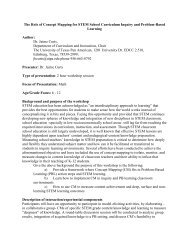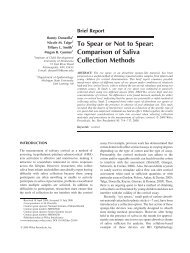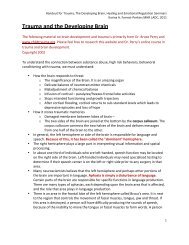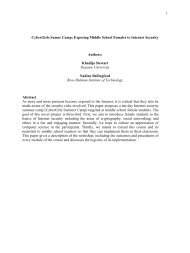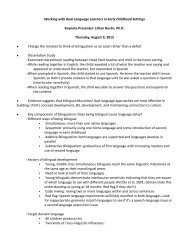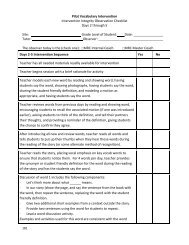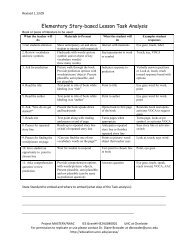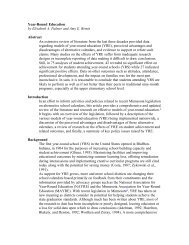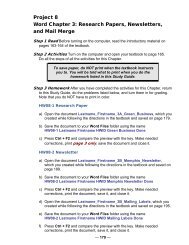Introduction to Positive Ways of Intervening with Challenging Behavior
Introduction to Positive Ways of Intervening with Challenging Behavior
Introduction to Positive Ways of Intervening with Challenging Behavior
You also want an ePaper? Increase the reach of your titles
YUMPU automatically turns print PDFs into web optimized ePapers that Google loves.
Attention Deficit Hyperactive Disorder...<br />
a guide for teachers and parents<br />
This Intervention Tip Sheet has been developed <strong>to</strong> assist teachers and parents in providing the best possible<br />
educational opportunities <strong>to</strong> students <strong>with</strong> emotional and behavioral disorders. This Tip Sheet was published by<br />
the Institute on Community Integration, College <strong>of</strong> Education, University <strong>of</strong> Minnesota, Minneapolis and was<br />
authored by Kareen Smith <strong>of</strong> the Institute.<br />
<strong>Introduction</strong><br />
Attention Deficit Hyperactive Disorder (ADHD - also referred <strong>to</strong> as ADDH and Attention Deficit Disorder, ADD)<br />
"describes a disorder in which a child displays significant difficulties <strong>with</strong> poor attention, impulsivity and<br />
overactive behavior" (Braswell, Bloomquist & Pederson, 1991, p.5).<br />
While most children display these behaviors at some time in their lives, children diagnosable as having<br />
ADHD display them in a way (frequency, duration, severity, etc.) which is significantly inappropriate for their<br />
mental age and at a significantly different rate than peers. Additionally, ADHD is a developmental disorder which<br />
persists through life (Kauffman, p. 291). Correlate behaviors <strong>of</strong> ADHD children can be observed as early as<br />
infancy. ADHD infants can be described temperamentally as being irritable, difficult <strong>to</strong> soothe and as having<br />
irregular sleeping and eating patterns.<br />
Prevalence<br />
ADHD is thought <strong>to</strong> affect 35% <strong>of</strong> elementary school age children. Because <strong>of</strong> how schools are run, <strong>with</strong> children<br />
being expected <strong>to</strong> be still and comply, ADHD students commonly have problems in school. Teachers commonly<br />
describe children <strong>with</strong> ADHD as <strong>of</strong>ten being <strong>of</strong>f-task, fidgeting, playing <strong>with</strong> objects (i.e., tapping pencils,<br />
playing <strong>with</strong> coins), impulsively vocalizing their feelings or reactions and <strong>of</strong>ten being out <strong>of</strong> their seat.<br />
Implications<br />
Problems associated <strong>with</strong> ADHD can lead <strong>to</strong> poor motivation and difficulty in developing problem-solving<br />
abilities. In order <strong>to</strong> help ADHD children succeed scholastically and socially, it is very important that there is<br />
intervention which is tailored <strong>to</strong> the child's specific needs (Braswell, et al.) Educational interventions are<br />
important <strong>to</strong> ensure that a child's educational needs are met; this can mean special services for children who have<br />
learning disabilities in addition <strong>to</strong> ADHD, time spent in a resource room or, possibly, self-contained settings. The<br />
trend <strong>to</strong>day is <strong>to</strong> provide more supports <strong>to</strong> the mainstream classroom rather than separating students. It is<br />
important that parents, teachers, and school faculty involved in designing a individual education plan do not<br />
assume that ADHD students are less intellectually competent than their classmates. In fact, research has shown<br />
little cognitive differences between ADHD and other children, nor do children <strong>with</strong> ADHD tend <strong>to</strong> have IQs<br />
outside <strong>of</strong> the normal range (Forness, Youpa, Hanna, Cantwell, & Swanson, 1992).<br />
Interventions<br />
Research and experience <strong>of</strong> individuals shows more and more that positive, proactive interventions used <strong>with</strong><br />
students <strong>with</strong> ADHD (and other emotional or behavioral disorder) are just as, if not more, effective than aversive,<br />
reactive interventions. It is also true that few teacher training programs provide training in proactive interventions<br />
and teachers (as well as parents) may find themselves <strong>with</strong> little information and few resources when attempting<br />
<strong>to</strong> implement proactive intervention.<br />
For these reasons, The Institute on Community Integration (ICI) has put <strong>to</strong>gether several worksheets which<br />
concisely illustrate different proactive interventions which have been found <strong>to</strong> be effective and are relatively easy<br />
<strong>to</strong> implement. These are strategies which have been shown <strong>to</strong> be especially useful in working <strong>with</strong> children (<strong>of</strong> all<br />
ages) who have emotional or behavioral disorder, such as ADHD. It is important <strong>to</strong> note that a child does not have




